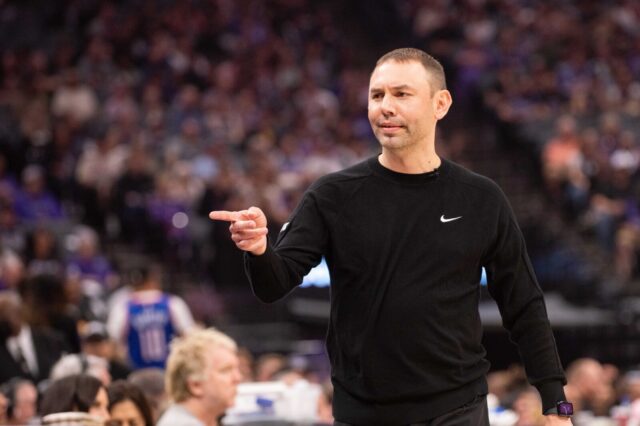The Denver Nuggets starting lineup has a spacing problem. In today’s NBA, it’s rare for a team to play with fewer than three reliable three-point shooters on the court at the same time but the Denver Nuggets start games with two players that have not made a three-pointer all year in Jusuf Nurkic and Kenneth Faried, and another in Emmanuel Mudiay who is shooting just 27.5% from behind the arc. The Nuggets have a -13 Net Rating when those three guys share the court together, the 3rd worst NetRtg among three-man Nuggets lineups to play at least 100 minutes so far this season.
This is largely due to conflicting skill sets. Mudiay’s best skill is getting into the paint and collapsing the defense for kickouts. In theory, his size should make him an excellent finisher at the rim but through one and a half seasons, that has not been the case.
One of Faried’s best offensive skills is his ability to finish above the rim on pick and rolls. Because of Faried’s athleticism, he creates a lot of gravity when he is able to roll into an empty painted area. Unfortunately, with Nurkic on the court, the painted area is rarely open.
One way the Nuggets can open things up a bit when both Nurkic and Faried are on the court is to run double high screens. The Charlotte Hornets do an excellent job of utilizing double high screens and it is a large part of why Kemba Walker is having the best season of his career. The Hornets play most of their minutes with two “traditional” bigs on the court. They start the game with Cody Zeller and Frank Kaminsky and run a bench unit that features both Roy Hibbert and Spencer Hawes.
Zeller is the roll guy who finishes very well when the help defense fails to rotate and makes smart passes when the defense collapses off of shooters in the corner. Kaminsky is the pop guy and uses his shooting touch to stretch the defense out to the three-point line above the break. In the video below, notice how wide open the painted area is with the two bigs out near the top of the key, ready to set the screen.
One of the issues that Mudiay has with basic pick and roll action is that defenders always slide under the screen against him, but with double stagger screens, the second screener is able to set the ball screen lower, chasing the defender down once he sees him try to go under the first screen. With double wedge screens, the defender is pinned, unable to go under the screen and forced to either switch or go over the top, putting pressure on the two bigs to provide help.
The Hornets run a lot of double high screens, both in transition and throughout their half court offense. In the half court, their bigs constantly search for opportunities to attack the on-ball defender with double screens, even after one or two ball rotations. The offense flows from one double screen to the next, sometimes three or four times before the offense creates an open shot.
Nurkic doesn’t have the range that Kaminsky does but if defenders sag too far off of him, he can catch the kickout and run right into a dribble handoff with the opposite wing. For example, look at the still frame below and imagine for a second that Nurkic is in Kaminsky’s shoes. Rather than shoot it, Nurk could run right into a DHO with Danilo Gallinari on the wing while his defender (in this example that is Kristaps Porzingis) is sprinting to recover from helping stop the roll guy. The action would almost certainly force a switch and a mismatch for both Gallo and Nurk.
This content is no longer available.
If you swap either Nurkic or Faried for Nikola Jokic, the action becomes even more deadly. If Jokic is the pop guy, he can take the wide open three. Both Kaminsky and Jokic are shooting similar percentages from behind the arc this season but the Hornets give Kaminsky the green light to take over four attempts per game. Jokic is much better than Kaminsky and should’ve fall in love with that shot but with Nurkic or Faried rolling hard to the rim, Jokic is likely to be left wide open. Kaminsky is among the league leaders in “wide open” three-point attempts per game and there is no reason to think that Jokic would not be equally as open in that spot.
If Jokic is the roll guy, he’d be like a super Cody Zeller, either finishing with his feathery touch or making quick reads to open shooters in the corner. Zeller and Jokic actually have a lot of similar qualities. Both guys are fairly passive when it comes to forcing shots for themselves but very good at creating shots for others, either through screens or through assists. Jokic has a lot more individual skill than Zeller which is why he can become even more effective in either role in double high screens.
The Nuggets appear to have abandoned the Jokic-Nurkic lineup completely but it may be worth revisiting for short stretches if the Nuggets can find an attack that doesn’t clog the paint. And even if they don’t revisit the Balkan Buddy Ball pairing, it’s still worth trying to open up the paint for Mudiay to do what he does best, especially when Nurkic and Faried are on the court.
For a more in-depth look at what is making Kemba Walker and the Charlotte Hornets hum on offense, check out the full article on VICE Sports.


